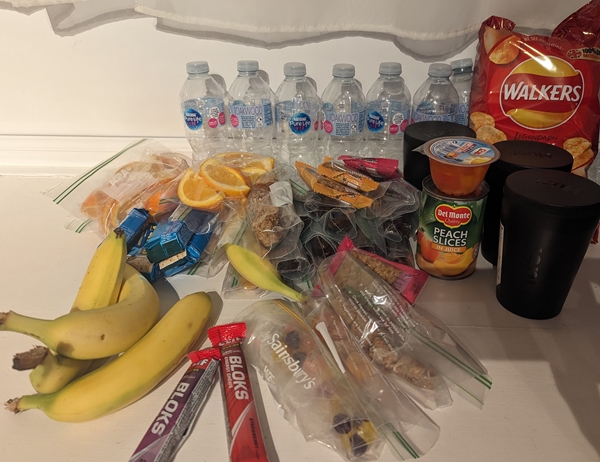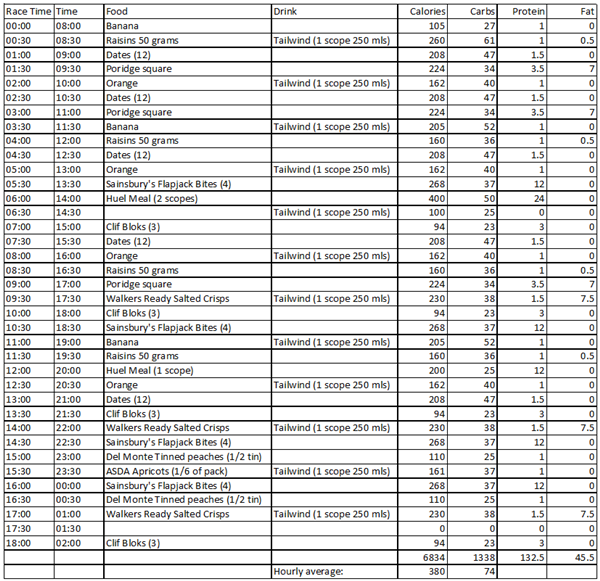An experiment in ultra marathon race nutrition and racing in bad weather
By the time I arrived at the athletics track at Walton-On-Thames, just a short 45 minute bike ride from home, I was already drenched and had to change into a dry set of clothes before the race had even started. And it didn’t help that some of my spare clothes, including two pairs of spare socks, had managed to get wet in my bag during the rainstorm I had cycled through.
By the time I lined up on the start line 25 minutes later I had also managed to lose one of the four gloves I had taken with me, and with the weather forecast, four gloves (two pairs) was never going to be enough. I was definitely under-prepared for the weather we would be facing during the race.
The day wasn’t going to plan!
My ultra marathon race nutrition experiment:
And speaking of plans, I was using the Phoenix Running 24 hour Track Race, a race I had completed last year, to test my nutrition strategy for next month’s 6-day race in France. I’ve always tried to eat regularly (every 30 minutes) during ultra-distance races but have never focussed too much on the nutritional content of what I’m consuming, nor the total calories or grams of carbohydrate.
I realise that when it comes to nutrition, what works for one person may not work for the next, and what works in one race may not work in the next, but a rough rule of thumb that I have read many times is 300-400 calories per hour and 1 gram of carbohydrate per kilogram of body weight per hour.
For the last few weeks, I’ve been analysing everything I’ve been eating and found that it is actually quite hard to consume (in my case) 85 grams of carbohydrate per hour whilst consuming only 400 calories – 85/400 is a ratio of 21%. I reviewed the foods that I usually eat during races and the only foods that came anywhere near a 21% ratio were fruit – both dried and fresh. And consuming more than 400 calories per hour while exercising is not recommended because your body needs blood circulation to the working muscles – to move forwards – and digestion takes the blood away from those working muscles (or something like that).
If I’m going to be eating every 30 minutes for 6 days – as I will be doing in the 6-day race – I want to be eating more than just fruit, and in the past I have consumed a wide range of foods during 6-day races to ensure variety but have only eaten ‘normal’ foods and have avoided ‘sports nutrition’.
This is partially because of some bad experiences during my triathlon days of the early/mid 90’s and also due to the cost of specialist sport nutrition products. But to consume the quantity of calories, and especially carbs, that I will need during the race I’ve decided it’s time to spend some money.
Surprisingly (to me anyway), specially developed endurance sport supplements have a lower carbs to calories ratio than I expected. In face Tailwind has a lower carbs/calorie ratio than Coca Cola and Clif Bloks have a lower ratio than fruit. I expect they are better quality carbs than you find in average foods though and I’ve purchased 10,000 calories of Clif Bloks (3 boxes of 18 packets) for this race plus the 6-day. They are easy to eat and can be used to top-up my carbs when needed.
I also bought some Tailwind, figuring that it may be easier to ‘top-up’ my calories and carbs by drinking them, especially in hot weather – i.e. not in the 24 hour race ☹. As with the Clif Bloks, the ratio of carbs to calories is only 25% – Coca Cola has a 28% carb/calorie ratio – but I assume they are better quality carbs.
Also, Tailwind only has 1 gram of carbohydrate per 10 millilitres of fluid (based on a normal concentration) whereas Coke as 1 gram of carbohydrate per 8.5 mls.
I decided I would attempt to consume an average of 380 calories and 75 grams of carbohydrate per hour for the whole race. Four litres of Tailwind would be my only drink other than water when needed. It wasn’t going to be hot, so an average of just 166 mls per hour should be sufficient, whereas in the 6-day in France in late April I should be able to double that quantity.
And for food, I would start off mainly with fruit (both dried and fresh) as I do in most races, and add in other foods as the race progressed. The only real difference being that the quantity of food consumed every 30 minutes would be a little more than usual.
To improve my overall nutrition at work, on the days that I walk to work (Tuesday through Friday), rather than buying lunch I’ve been eating Huel ready meals – 400 calories of pasta-based meals which have added minerals, vitamins, etc. I’m also intending on eating the Huel ready-meals during the 6-day, so for the 24-hour I decided to have half a meal every six hours. 200 calories, 25 grams of carbohydrate.
For the 6-day race this year, I’ll be consuming Huel meals as well as some frozen pasta-based meals that my wife, Ruth, is preparing. They will be frozen when we leave London for the race and we will put them in the fridge when we get there with the intention that they should be Ok for the first three or four days of the race. The idea being that both of these types of meals will be more nutritious than what I have been eating in previous 6-day races. Ruth’s meals won’t be high carb – at a ratio of about 9-10% carbs to calories, but will contain veges and other ingredients that should help me get through the race in better condition than previous years. The Huel meals are 13% carbs to calories.
Without access to a microwave at the 24 hour race, the Huel meals were the only new food that I haven’t eaten during races previously.

The Race:
My goal for the 24 hour race was to average 7km per hour and try to hold that pace throughout the night, ideally finishing with a total of around 170km although anything over 161km (100 miles) would be satisfactory. Last year I eased up after 18 hours and cruised through to 164km at the finish. And then in the 6-day (in April last year) I completed 168km in the first 24 hours, and 170km in the first 24 hours of my last race – the Gloucester 48 track hour race in August in which I DNF’d at 32 hours.
The race started OK. 22km in the first three hours, 50km in 6:55. It had rained on and off, but wasn’t too bad, but by 9 ½ hours I was cold, wet, and starting to struggle. I had my first stop to change clothes and by 10 hours my overall average pace had now dropped below 7km/hour.
Worse was to come though, and in the next two hours I walked less than 12km – 81.6km (50.7 miles) in 12 hours. I remember at one stage trying to put a second rain jacket over the top of my main jacket and being so cold that I couldn’t do up the zip. And due to a lack of gloves, and frozen hands, I was wearing a pair of waterproof socks as gloves.
One good thing was that I had some hand-warmers with me. These are small crystals that when kneaded, generate heat. Without these I would have been in serious trouble. As it was, my hands were still sore from the cold 12 hours after I finished the race.
I stuck to my nutrition plan though and tried to push the pace. For a while I was holding the 6.6km per hour that I needed to reach 100 miles by the end of the 24 hours. I reached 100km in 14:46 but I was starting to experience stomach cramps. I don’t think they were caused by my nutrition strategy, but I had worked out that I can’t handle dried apricots and I decided to swap out my hour 18 Huel meal with Clif shots as I didn’t feel like eating another Huel meal.
I had also been struggling for several hours with the start of blistering under the front of my left foot – the padded area between the ball of my foot and the outside of the foot. I stopped to tape the area at 11 hours and took some painkillers a while later.
This is the same problem I had in the 48 hour race back in August. That race was also a track race. The constant turning on the track was causing problems with my feet. The question is, why? I’ve done plenty of 100 mile/24 hour track races without any problems. The August race was double the distance, which is what I put the blistering down to, and this time it was the wet feet – my feet were constantly moving within my shoes – slipping on my orthotics.
In long races I wear extra wide shoes with two pairs of socks. I have wide feet and used to blister on the sides on my feet and toes until I discovered extra wide shoes, but perhaps in track races I need tighter shoes. Another possibility is that 15 months ago (shortly after walking 178km on the track in the 2022 NZ Centurion race) I got new orthotics which have a different surface on the top, and definitely in the rain this makes them a little slippery because they don’t absorb moisture like my previous orthotics did. Could this be the problem?
Regardless of the cause, with my decreasing pace and the threat of another downpour I decided to DNF just short of 19 hours, at 124km.
My main rational for the DNF, which 36 hours later I still think was the right decision, was that if I tried to push through on a blistered foot, I could end up altering my gait which could result in injury. My most important race this year in next month’s 6-day race in Vallon Pont d’Arc, and I couldn’t risk getting injured in a race where I was going to be unhappy with the result anyway.
What’s Next:
I’ll take a week to recover and then I have three more high-mileage weeks planned before a three week taper through to the race. I’ll also be spending more time working on the nutrition plan for the race.

